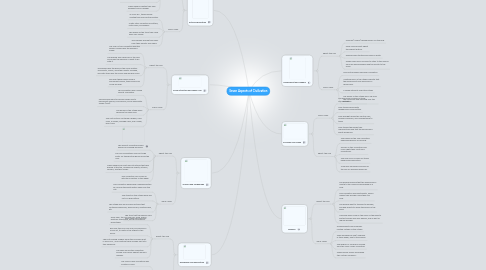
1. Science and Technology
1.1. Egypt: the Nile
1.1.1. The ancient civilizations were known for building pyramids.
1.1.2. The Nile civilizations also built large boats for transporting goods along the river.
1.1.3. These people also built rigid structures that held pharoh at the top, followed by priests, artisans, farmers, and then slaves.
1.1.4. This civilization also came up with the invention of the wheel.
1.2. Indus Valley
1.2.1. This civilization developed a sewage system by running the waste water away from the city.
1.2.2. The streets in the citadel were laid out in a grid pattern.
1.2.3. The citadel was an enclosed fortress that contained graineries, ware houses, meeting halls, etc.
1.2.4. The tools that the people used were made very similarly.
2. Geography and Agriculture
2.1. Egypt: the Nile
2.1.1. Every year, the Nile river will flood, which destroys everything, but this flooding is predictable.
2.1.2. Because the Nile is so long, and carries so much silt, it's delta is the largest in the world.
2.1.3. The first farming villages along the Nile were built in 5000 B.C., and overtime these villages split into two kingdoms.
2.1.4. The seas around the civilization served as a barrier against war and disease.
2.2. Indus Valley
2.2.1. The Indus Valley civilization was located in India.
2.2.2. These people were originally hunter/ gatherers, who slowly began to farm.
2.2.3. This civilization began in 2500 B.C.
2.2.4. The majority of the jobs available were herding livestock and farming. Another one was weaving/ crafting.
3. Social Structure and Family Life
3.1. Egypt: the Nile
3.1.1. The ruler of this civilization was the pharoh. Pharoh was the king and leader.
3.1.2. The pharoh also owned all of the land and made the decision of what to do with it.
3.1.3. The pharoh was the head of the social system. The priests, viziers, and other royalty followed, and after them was the slaves and working class.
3.1.4. Because these people lived in permanent homes, their family size could be large.
3.2. Indus Valley
3.2.1. This civilization was a single society civilization.
3.2.2. Families were able to become larger due to permanent homes, food surplus, and a large water supply (river).
3.2.3. The homes in the citadel were generally the same size.
3.2.4. The cast system contained a higher, royal class, a middle, average class, and a lower, poor class.
4. Arts and Education
4.1. Egypt: the Nile
4.1.1. Common architecture in Egypt was the pyramids.
4.1.2. Painting and sculptures were produced for tombs and temples.
4.1.3. The people here loved to sing, and play harps, lupes, and other string instruments.
4.1.4. These people created their own alphabet and a calender.
4.2. Indus Valley
4.2.1. In 2500 B.C., these people created their own writing system
4.2.2. Crafts often consisted of pottery, metal work, and jewelry.
4.2.3. The design of the tools they used were very similar.
4.2.4. The children learned their skills from their parents and elders.
5. Government and Leaders
5.1. Egypt: the Nile
5.1.1. Officials (Viziers) helped govern for the king.
5.1.2. Kings ruled ancient Egypt throughout history.
5.1.3. Pharohs were treated like Gods on Earth.
5.1.4. People were more inclined to listen to the Pharoh since he was worshiped and the mouth to the Gods.
5.2. Indus Valley
5.2.1. One central power held over civilization
5.2.2. "Meeting halls" in the citadel indicate that the government may have been a democracy.
5.2.3. A single authority ruled the citadel
5.2.4. The leader of the citadel has a say over the uniformity and planning over the citadel.
6. Economy and Trade
6.1. Indus Valley
6.1.1. The economy focused on trade and agriculture.
6.1.2. They traded goods with neighboring communitites
6.1.3. They brought goods the Central Asia, Arabian Peninsula, and Mesopotamia to trade.
6.1.4. They traded the goods they manufactured and that the animals and plants produced.
6.2. Egypt: the Nile
6.2.1. The people of the Nile civilization depended heavily on farming.
6.2.2. Women in this civilization had more rights than most early civilizations.
6.2.3. The main form of work for these people was agriculture.
6.2.4. Trade was necessary because of the lack of available resources.
7. Religion
7.1. Egypt: the Nile
7.1.1. The people believed that the Pharoh was a mouth to the Gods and worshiped as a God.
7.1.2. This civilization was polytheistic, which means they worship more than one God.
7.1.3. The people went to temples to worship, and had priests to speak the words of the gods.
7.1.4. Offerings were made in the name of the gods to protect people and save people, and as part of regular worship.
7.2. Indus Valley
7.2.1. Archaeologists found shrines located outside of the citadel
7.2.2. They worshiped a God/ Goddess or their leader, due to the shrines.
7.2.3. The religion of Hinduism evolved from the Indus Valley civilization.
7.2.4. These people mainly worshiped "the Mother Goddess."
